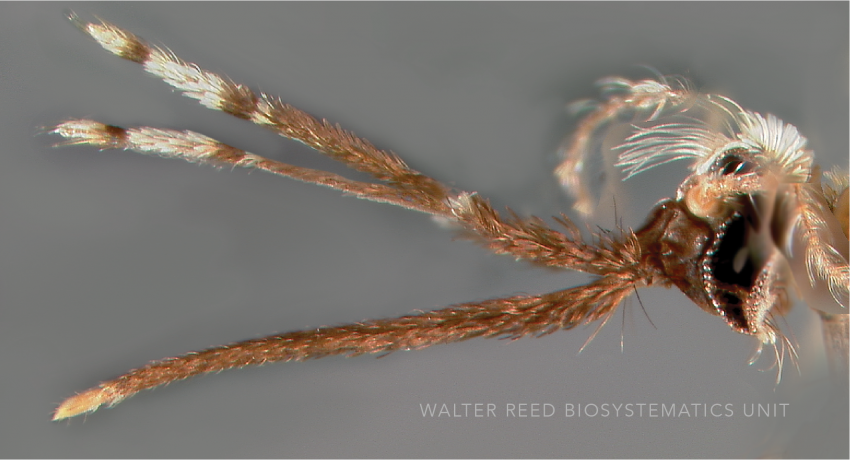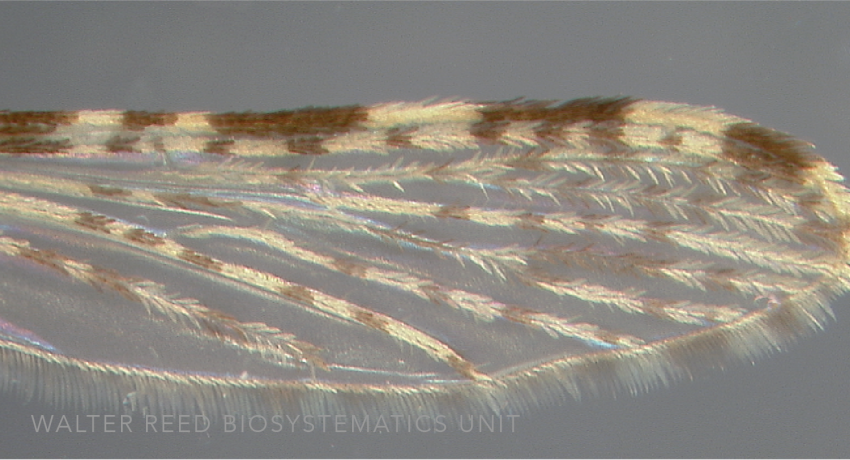AUSTRALASIAN & ORIENTAL REGIONS
View Anopheles punctulatus group taxonomic timeline
Etymology: Gaudens Charles Faraut
Anopheles farauti is a handsomely ornate species, crowned with a shock of white erect scales on its head, and plentiful small pale spots over its legs and wings. The species has one synonym, moluccensis Swellengrebel & Swellengrebel de Graaf, which was described from various localities in Papua New Guinea and the Moluccas. Anopheles farauti is the nominotypical member of the Farauti Complex which comprises five species—An. farauti s.s., An. hinesorum Schmidt (= An. farauti 2), An. irenicus Schmidt (= An. farauti 7), An. oreios Bangs & Harbach (= An. farauti 6), and An. torresiensis Schmidt (= An. farauti 3). Three others—An. farauti 4, 5 and 8—are recognized pending formal description, and phylogenetic treatments suggest that the taxa dubbed An. farauti 4 is actually most closely related to An. punctulatus Dönitz. The nuclear rDNA ITS2 region is proving the most reliable for robust species recognition within the Farauti Complex. Although the newly discovered An. farauti 8 displays the same ITS2 sequences as An. farauti s.s., they can be differentiated by a species-diagnostic ITS1 PCR-RFLP using the restriction enzyme Msp I. Anopheles hinesorum comprises multiple ITS2 genotypes, two of which are zoophilic, suggesting even further hidden diversity in the Farauti Complex.
Type locality: Faureville, Vate [Efate], New Hebrides Islands
Type depository: Institut Pasteur, Paris, France (PIP)
DIAGNOSTIC CHARACTERS (Click photos to view; mouse over and click large photo to zoom in.)
ADULT (illustrated): Head: Proboscis dark-scaled except for indistinct pale band at apex; MPlp3 with a broad apical band, a narrow dark sub-basal band and a narrow basal white band; MPlp5 dark basally. Thorax: Scutum with broad decumbent pale scales throughout; halter capitellum black-scaled dorsally; sterna mostly bare; terga without dense scales. Wing: Numerous dark and pale spots on wing; veins R-R1 with 9–17 dark spots or patches. Legs: Ta-I2–5 and Ta-II2–5 black and white spotted.
LARVA (not illustrated): Head: Seta 2-C widely separated. Thorax: Setae 9–12-P long, single: basal tubercles of setae 1–3-P usually fused; seta 1-M plumose; seta 1-I small, distinctly palmate with broad leaflets.
TAXONOMIC KEYS
Lee et al. 1987b
Becker et al. 2010
![]()
WRBU – Anopheles - Neomyzomyia Series - Australasian Region - Larva
![]()
WRBU – Anopheles - Neomyzomyia Series - Indomalayan Region - Adult
![]()
WRBU – Anopheles - Neomyzomyia Series - Indomalayan Region - Larva
![]()
WRBU - Genera - Global - Adult
![]()
WRBU - Genera - Global - Larva
![]()
WRBU - Genera - Australasia - Adult
![]()
WRBU - Genera - Australasia - Larva
![]()
WRBU - Genera - Indomalaya - Adult
![]()
WRBU - Genera - Indomalaya - Larva
![]()
WRBU - Anopheles Subgenera and Series - Australasia - Adult
![]()
WRBU - Anopheles Subgenera and Series - Indomalaya - Adult
![]()
WRBU - Anopheles Subgenera and Series - Indomalaya - Larva
Exemplar DNA sequences
An. farauti s.s. rDNA ITS1 & ITS2: EF042718–21
BIONOMICS
Immatures
Immatures of An. farauti s.s. are typically found in heavily shaded, saline or brackish water habitats—lagoons, coastal mangrove swamps and brackish pools—with emergent, floating and submerged vegetation or algae. An. hinesorum and An. torresiensis are found in freshwater habitats. Anopheles farauti s.l. have been collected in artificial containers, but it is unclear which sibling species these belong to.
Adults
Anopheles farauti s.s. is a common species, usually found within a kilometer of the coast. Anopheles farauti 4 is more common inland, but can also be collected in low numbers in coastal sites, Anopheles farauti 8 occurs only inland, and An. oreios is a highland species. Anopheles farauti s.s. and An. farauti 4 are regarded as primary malaria vectors. Anopheles farauti 8, the largest species of the Farauti Complex, is a proven field malaria vector, and An. orieos has been circumstantially incriminated.
DISTRIBUTION NOTES
Australia, Indonesia (includes Borneo, Moluccas, Sulawesi), Malaysia, Papua New Guinea, Solomon Islands, Vanuatu.

WRBU VECTOR HAZARD REPORTS
None; View other WRBU Vector Hazard Reports
Available GIS Models
An_farauti_Nyari_1 Australasia
IMPORTANT REFERENCES (full citations below)
Laveran 1902b: 908 (F)
Lee & Woodhill 1944: 140 (M, F*, L*, E*; as moluccensis)
Knight & Farner 1944: 132 (from synonym with punctulatus)
Rozeboom & Knight 1946: 120 (F*, P*, L*; taxonomy)
Reid 1947: 90 (taxonomy)
Horsfall 1955: 210 (bionomics)
Belkin 1962: 138 (M*, F*, P*, L*)
Bryan & Coluzzi 1971 (chromosomes*)
Bryan 1973: 64 (taxonomy)
Maffi 1973a: 29 (taxonomy)
Bryan 1974: 413 (taxonomy)
Mahon & Miethke 1982 (s.l.; farauti 1,2,3)
Sweeney 1987 (bionomics)
Lee et al. 1987b: 165 (F key, taxonomy, bionomics, distribution, review)
Foley & Bryan 1993 (molecular taxonomy; s.l.)
Foley et al. 1993 (molecular taxonomy; s.l.)
Schmidt et al. 2001: 391 (M, F, P*, L*; taxonomy; s.l.)
Bower et al. 2008 (molecular taxonomy)
Cooper et al. 2009 (bionomics, biomedical importance; s.l.)
Becker et al. 2010: 356 (F*, L*; key, taxonomy, distribution, bionomics; s.l.)
Sinka et al. 2011: 89 (Farauti Complex; bionomics review, distribution, niche model)
Bangs et al. 2014 (review, bionomics, taxonomy; s.l.)
Beebe et al. 2015 (review)
CURRENT SYNONYMS
syn. moluccensis Swellengrebel & Swellengrebel de Graaf
1920 (1919): 1 (L*; annulipes variety), 29 (M, F; annulipes variety). Type locality: Several localities in Moluccas & Western New Guinea (Papua) (NE). References: Knight & Farner 1944: 132 (synonymy).
CITED REFERENCES
Bangs, M. J., Taai, K., Howard, T. M., Cook, S., & Harbach, R.E. (2014). The mosquito Anopheles (Cellia) oreios sp. n., formerly species 6 of the Australasian Anopheles farauti complex, and a critical review of its biology and relation to disease. Medical and Veterinary Entomology, 29(1), 68–81.
Becker, N., Petrić, D., Zgomba, M., Boase, C., Madon, M., Dahl, C., & Kaiser, A. (2010). Mosquitoes and their control (Second ed.). Berlin Heidelberg: Springer-Verlag.
Beebe, N.W., Russell, T., Burkot, T.R., & Cooper, R.D. (2015). Anopheles punctulatus group: evolution, distribution, and control. Annual Review of Entomology, 60, 335–350.
Belkin, J.N. (1962). The mosquitoes of the South Pacific (Diptera, Culicidae) (Vols. 1 &2). Berkeley, California: University of California Press.
Bower, J.E., Dowton, M., Cooper, R.D., & Beebe, N.W. (2008). Intraspecific concerted evolution of the rDNA ITS1 in Anopheles farauti sensu stricto (Diptera: Culicidae) reveals recent patterns of population structure. Journal of Molecular Evolution, 67(4), 397–411.
Bryan, J.H. (1973). Studies on the Anopheles punctulatus complex I. Identification by proboscis morphological criteria and by crossmating experiments. II. Hybridization of the member species. III. Mating behaviour of the F1 hybrid adults from crosses between Anopheles farauti no. 1 and Anopheles farauti no. 2. Transactions of the Royal Society of Tropical Medicine and Hygiene, 67(1), 64–91.
Bryan, J.H. (1974). Morphological studies on the Anopheles punctulatus Donitz complex. Transactions of the Royal Entomological Society of London, 125(4), 413–435.
Bryan, J.H., & Coluzzi, M. (1971). Cytogenetic observations on Anopheles farauti Laveran. Bulletin of The World Health Organization, 45, 266–267.
Cooper, R.D., Waterson, D.G.E, Frances, S.P., Beebe, N.W., Pluess, B., Sweeney, A.W. 2009. Malaria vectors of Papua New Guinea. International Journal for Parasitology, 39, 1495–1501.
Foley, D.H., & Bryan, J.H. (1993). Electrophoretic keys to identify members of the Anopheles punctulatus complex of vector mosquitoes in Papua New Guinea. Medical and Veterinary Entomology, 7, 49–53.
Foley, D.H., Paru, R., Dagoro, H., & Bryan, J.H. (1993). Allozyme analysis reveals six species within the An. punctulatus complex of mosquitoes in Papua New Guinea. Medical and Veterinary Entomology, 7(1), 37–48.
Horsfall, W.R. (1955). Mosquitoes. Their bionomics and relation to disease. New York, NY: Hafner Publishing Company. (Reprinted 1972).
Knight, K.L., & Farner, D.S. (1944). A correction in anopheline nomenclature (Diptera, Culicidae). Proceedings of the Entomological Society of Washington, 46, 132–133.
Laveran, A. (1902b). Sur des culicides de Nouvelles-Hebrides. Comptes Rendus Société de Biologie, 54, 908–910.
Lee, D.J., & Woodhill, A.R. (1944). The Anopheline mosquitoes of the Australasian Region (Vol. 2). Australia: University of Sydney.
Lee, D.J., Hicks, M.M., Griffiths, M., Debenham, M.L., Bryan, J.H., Russell, R.C., . . . Marks, E.N. (1987b). The Culicidae of the Australasian region. Volume 5. Commonwealth Department of Health, School of Public Health and Tropical Medicine Monograph Series, 2.
Maffi, M. (1973a). Morphological observations on a population of the punctulatus complex of Anopheles (Diptera, Culicidae) from Rennell Island (Solomon Group). Natural History of Rennell Island, British Solomon Islands, 7, 29–39.
Mahon, R.J. & Miethke, P.M. (1982). Anopheles farauti No. 3, a hitherto unrecognized biological species of mosquito within the taxon A. farauti Laveran (Diptera: Culicidae). Transactions of The Royal Society of Tropical Medicine and Hygiene, 76(1), 8–12.
Reid, J.A. (1947). Type specimens of Culicidae described by Laveran (Diptera: Culicidae). Proceedings of the Royal Entomological Society (B), 16, 86–91.
Rozeboom, L.E., & Knight, K.L. (1946). The punctulatus complex of Anopheles (Diptera: Culicidae). Journal of Parasitology, 32, 95–131.
Schmidt, E.R., Foley, D.H., Hartel, G.F., Williams, G.M., & Bryan, J.H. (2001). Descriptions of the Anopheles (Cellia) farauti complex of sibling species (Diptera: Culicidae) in Australia. Bulletin of Entomological Research, 91, 389–410.
Sinka, M.E., Bangs, M.J., Manguin, S., Chareonviriyaphap, T., Patil, A.P., Temperley, W.H., ... Hay, S.I. (2011). The dominant Anopheles vectors of human malaria in the Asia-Pacific region: Occurrence data, distribution maps and bionomic précis. Parasites & Vectors, 4(1), 89.
Sweeney, A.W. (1987). Larval salinity tolerances of the sibling species of Anopheles farauti. Journal of the American Mosquito Control Association, 3(4), 589-592.
Swellengrebel, N.H., & Swellengrebel de Graaf, J.M.H. (1920). Addenda to bescription [sic] of larvae of Netherlands Indian anophelines. Burgerlijken Geneeskundigen Dienst in Nederlandsch-Indie. Mededeeligen., 9(1919)(Add.)), 1–3.
CITE THIS PAGE
Walter Reed Biosystematics Unit (Year). Anopheles farauti species page. Walter Reed Biosystematics Unit Website, http://wrbu.si.edu/vectorspecies/mosquitoes/farauti, accessed on [date (e.g. 03 February 2020) when you last viewed the site].











































































































































































